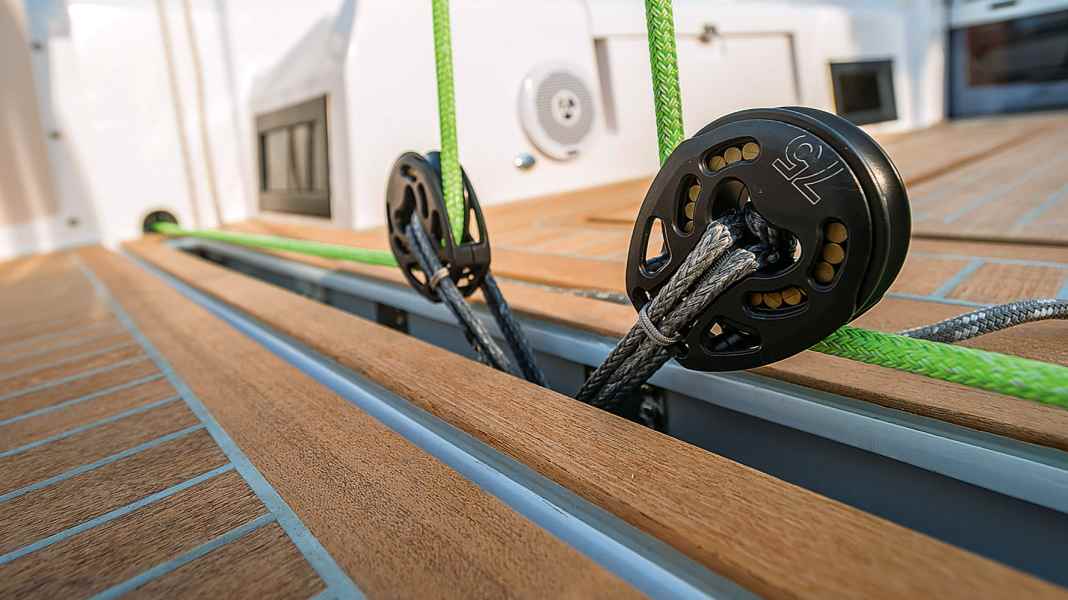
- Survival of the fittings
- Only a well-aligned block runs easily
- Plain bearings: frugal and favourable
- Ball bearing: smooth running, limited load capacity
- Plain and ball bearings: universal combination
- Roller bearings: efficient but expensive
- Thimbles: Slide bearing made of Dyneema
- What the bearings are made of
- details
- Double block or violin
Practically nothing works on a sailing yacht without blocks. Whether on halyards, sheets, backstay, boom vang, trim elements or just the flag line: ropes and blocks are omnipresent on board. The seemingly simple fittings ultimately have a decisive influence on the function and operability of the boat.
A good example is the mainsheet. Whether it can still be trimmed easily even with more pressure depends not only on the reduction ratio and the point of attack on the boom, but also on the blocks used, or more precisely: their disc diameter and bearing.
The larger the disc diameter, the better. There are two reasons for this: The smaller the deflection radius, the more the cordage is deformed, which means that the braid has to work harder and the fibres are unevenly loaded. Rope manufacturers therefore often specify a minimum diameter. The braided constructions commonly used today are based on eight times the rope diameter. Ideally, a 10 mm sheet should therefore run over an 80 mm disc, but you will hardly find this on board production boats. There, 50 to 75 millimetres are the order of the day. In violin blocks or thimbles, the rope usually runs over much smaller radii.
Also interesting:
A smaller line diameter means more friction, as the disc has to rotate faster. This brings the disc bearing and the inevitable friction into play. This may hardly be noticeable when hauling tight, as the frictional force is superimposed on the force required to trim the sail and is therefore simply held for the wind pressure. However, if the sheet is to be furled in light winds, the frictional effects become apparent. Especially when the tack is set too low, the sheet will often come out unwillingly after releasing the cleat. This is a clear sign of unfavourable rope/block combinations and stiff bearings.
Speaking of bearings: almost all manufacturers have different types on offer. This is partly due to the fact that different price segments and customer requirements need to be catered for, but also because each design has advantages and disadvantages. So there is no universal truth. It is much more important to match the design and storage technology to the respective application.
Survival of the fittings
The decisive factor is whether the block is subjected to dynamic or static loads. When used on board, a distinction is made between three scenarios: dynamic loads such as in the mainsheet mentioned above, where the discs have to move frequently but are only exposed to moderate loads. Static loads such as on a halyard, backstay or boom vang. Here, the pulleys are under a high permanent load, but hardly have to move at all. And finally, shock loads, such as those generated by a patent jib or a suddenly popping spinnaker.
The main concern here is the survival of the fittings. The pane, bearing and fixing must not be able to move at the moment of shock, but must not be damaged by the load peak. To help you choose the right bearing technology, we have summarised the advantages and disadvantages in individual info boxes.
When choosing the block, however, it is not only the bearing technology that plays a role, it is also necessary to clarify which forces the fitting must be able to withstand. The good news is that, apart from patented jibes, there will hardly be any problems with hand-trimmed sheets. As a rule, the rope diameter used automatically determines a sufficiently dimensioned fitting, as the line has to fit through the block.
It becomes more risky if the cordage has been thinned down to the minimum for weight reasons or the sheet is run over a winch as a German mainsheet system, for example. In this case, it is better to keep an eye on the working load. This also applies to the smooth running of the blocks. The manufacturer's catalogue specifications are not always optimal, especially for blocks with ball bearings. As our tests have shown in the past, the friction of these blocks increases significantly at half the catalogue specification. And this is practically independent of the manufacturer. It is therefore worthwhile dimensioning the fitting generously.
Only a well-aligned block runs easily
However, there is another danger lurking, because as the size of the block increases, so does the gap between the disc and the side panel. If the line is pulled in there, the block jams and nothing works. In the worst-case scenario, the cordage will literally burst the block and be damaged in the process.
The combination of thin Dyneema single braids and large gaps is particularly risky. If the block is not perfectly aligned, for example because the swivel is jammed, the line can run out of the groove into the gap and pull itself into the bearing.
Rope shackles or Dyneema loops are no substitute for a smooth-running swivel. Only a well-aligned block runs smoothly and reaches its full working and breaking load. In this context, the use of Dyneema loops or cordage shackles is often misjudged. The textile connectors appear soft and supple and allow the block to swivel wonderfully in the direction of force during the hand pull test. In sailing mode, however, things can look very different. When a serious load is applied to the loop or shackle, it is anything but supple. The material becomes rigid and takes on the most favourable shape for the direction of pull. In doing so, it develops an enormous torque that can force the attached block into a significant inclined position. Care must be taken to ensure that the attachment point and the desired alignment of the block axis are aligned. It may be possible to minimise the problem by crossing the shackle.
To ensure that the block runs smoothly for a long time, it must be maintained. The following applies: the more complex the bearing and the higher the load, the more maintenance is required. In this respect, sliding thimbles are the clear winners. All other fittings should be rinsed regularly with fresh water. Ball and roller bearing blocks can often be dismantled, alternatively they can be cleaned in an ultrasonic bath.
Plain bearings: frugal and favourable
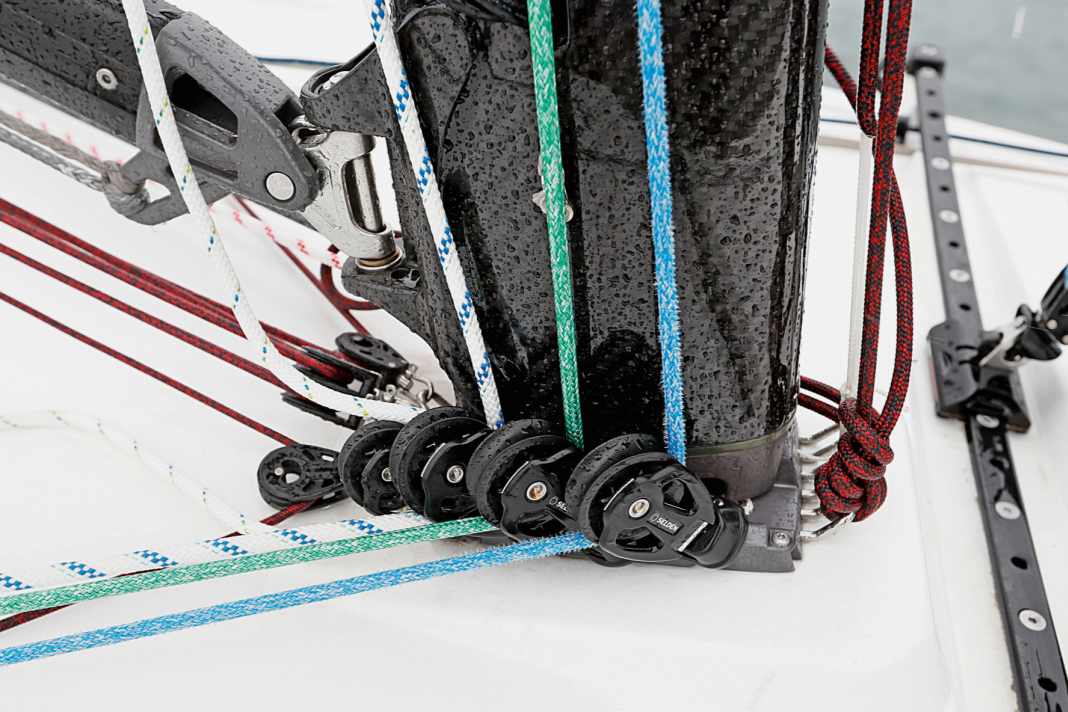


The simple storage technology can withstand high loads
A block can hardly be built with fewer moving parts. The pulley rotates directly on the stainless steel axle, which is usually shaped as a rivet and holds the side parts of the block together. The main advantages of this design are its low maintenance requirements, long service life and high load-bearing capacity. In addition, plain bearing blocks can be manufactured cheaply, they consist of few parts and do not require extremely low tolerances. The pulley can be made of metal or plastic. The latter often run directly on the metal axle. More sophisticated models have a bush made of special bearing plastic. As the contact surface of the bearing is relatively large, the blocks can withstand high loads. However, the large contact surface also generates more friction.
This becomes all the more apparent the faster the pulley is supposed to turn. This means that the sheet does not run out as well or cannot be tightened as quickly. With small rope movements, on the other hand, the friction of the bearing does not play a major role. Plain bearing blocks are therefore ideal wherever static loads are involved. For example, as halyard swivels or in downhaul or backstay buoys. Due to their universal character, they can also be used everywhere else, but do not offer optimum operating comfort. Lines running in at an angle should be avoided at all costs. The simple bearing can only absorb forces acting at 90 degrees to the axis; this is also referred to as radial loading. If the block cannot align itself freely, the disc in the housing tilts and friction and wear increase significantly. This can cause problems in multiple blocks.
Valuation
- + Favourable
- + Tolerates static load
- + Low maintenance
- - Friction during fast fetching and releasing
Ball bearing: smooth running, limited load capacity
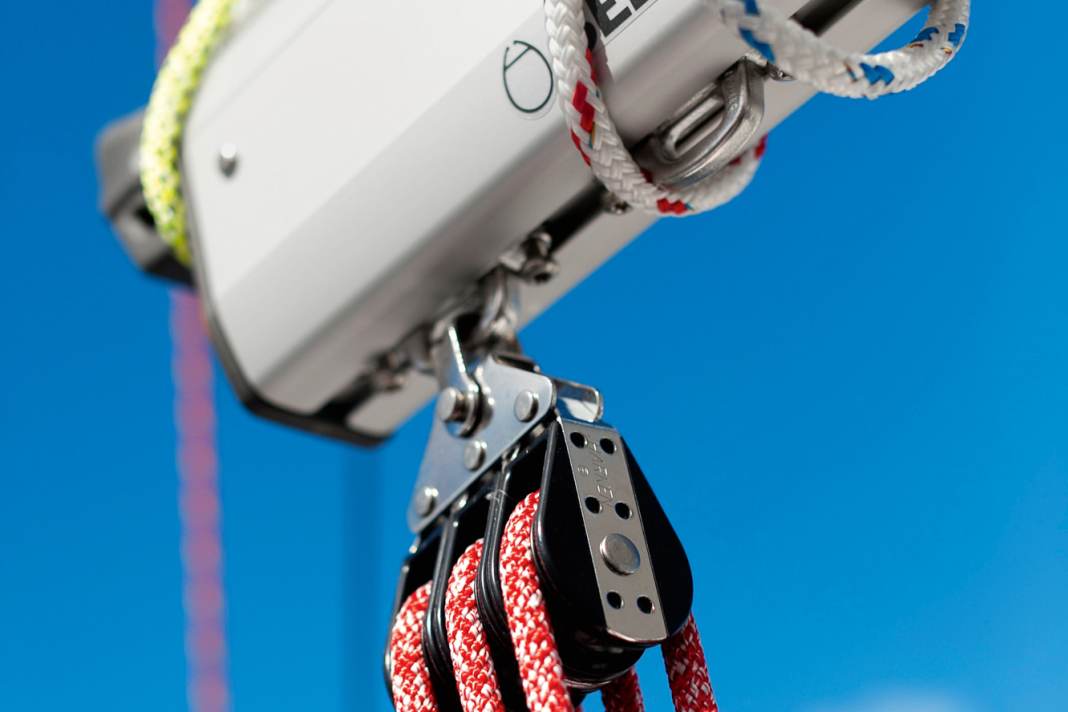


The small contact surface is both a blessing and a curse
On board, the triumphant advance of ball bearings began with the Harken brothers' bullet blocks. They used plastic balls, which were not only lighter than their metal siblings, but also did not require lubrication. This made the blocks smoother-running than anything previously available. The trick is the small contact surface of the balls. It generates hardly any friction, but is also the Achilles' heel of the blocks. This is because point loads occur, the balls deform or press into the raceway, blocking the bearing or bursting. The problems increase the higher the load and the less the disc moves, which is why ball bearing blocks should not be used as drop deflectors. On the other hand, they are well suited for a mainsheet or as a deflector for spinnaker and gennaker sheets.
Overloaded ball bearing blocks can be recognised by a rattling noise, in which case they should be replaced. A large diameter helps to increase the load-bearing capacity of the bearings so that the pressure is distributed over many balls. In Harken's Carbo blocks, the raceway in the load-bearing part has a round profile to provide a larger contact surface, while the idling part has a square, low-friction profile. Allen works with metal balls and tracks reinforced with stainless steel rings to prevent the balls from being pressed in. Another approach is the combination of more pressure-resistant Torlon balls and aluminium discs. The latest development is ceramic bearings. They are used in the Zirkon series from Harken and run with significantly less friction, but can hardly withstand shock loads. They are currently only suitable for small boats.
Valuation
- + Very smooth running
- - Low load capacity
- - Elaborate design/expensive
- - Must be rinsed
Plain and ball bearings: universal combination
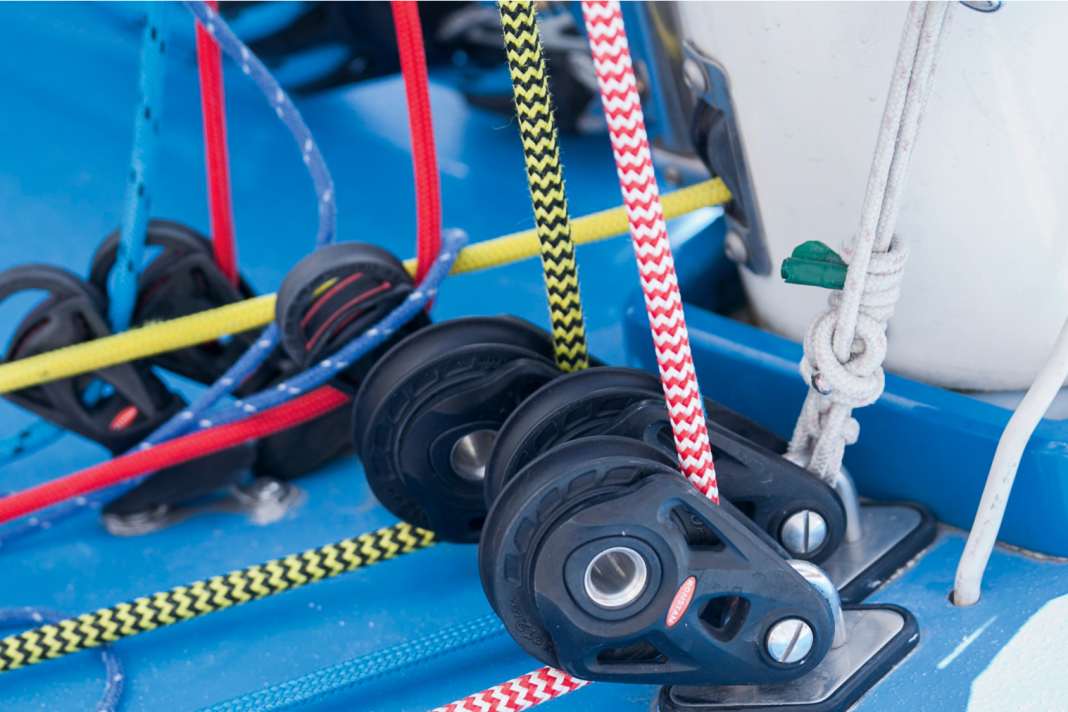



The system can withstand high loads and runs smoothly
Plain bearings are good for high loads, but run more slowly, whereas ball bearings show their advantages at low loads, but deform if the pressure is too high - why not combine the two? This is exactly what happens in blocks with two-stage bearings. Ronstan's Core and Orbit blocks with 30 to 55 millimetre disc diameters have this system. At low loads, the disc runs on lateral Delrin ball bearings and rotates very easily. The joke here is that the elasticity of the balls is built in.
If the forces increase, the bearings deform and the central sliding bush takes over. Although this increases friction, the large-surface support can also absorb very high loads without damaging the block. If the load on the system drops, the balls spring back and the disc runs on the smooth-running ball bearings again. This makes the blocks practically universally usable. However, you should keep an eye on the permissible working load. The lateral ball bearings also help with lines running in at an angle, they absorb the tilting moments and prevent the discs from rubbing against the block housings. This reduces wear and the fittings retain their good running properties for longer than simple plain bearing blocks.
The OPF and looper blocks from Antal and the EPS blocks from Harken as well as the HTX series from Lewmar also work with two bearing systems. However, the central sliding bush is always in contact with the shaft, which means that they run somewhat slower under low loads. As with Ronstan, the ball bearings absorb lateral forces and prevent the disc from tilting, which means that the blocks run more smoothly than plain bearing blocks if they are not perfectly aligned.
Valuation
- + Good for static load
- + Low friction with light load
- - Elaborate design/expensive
- - Must be rinsed
Roller bearings: efficient but expensive
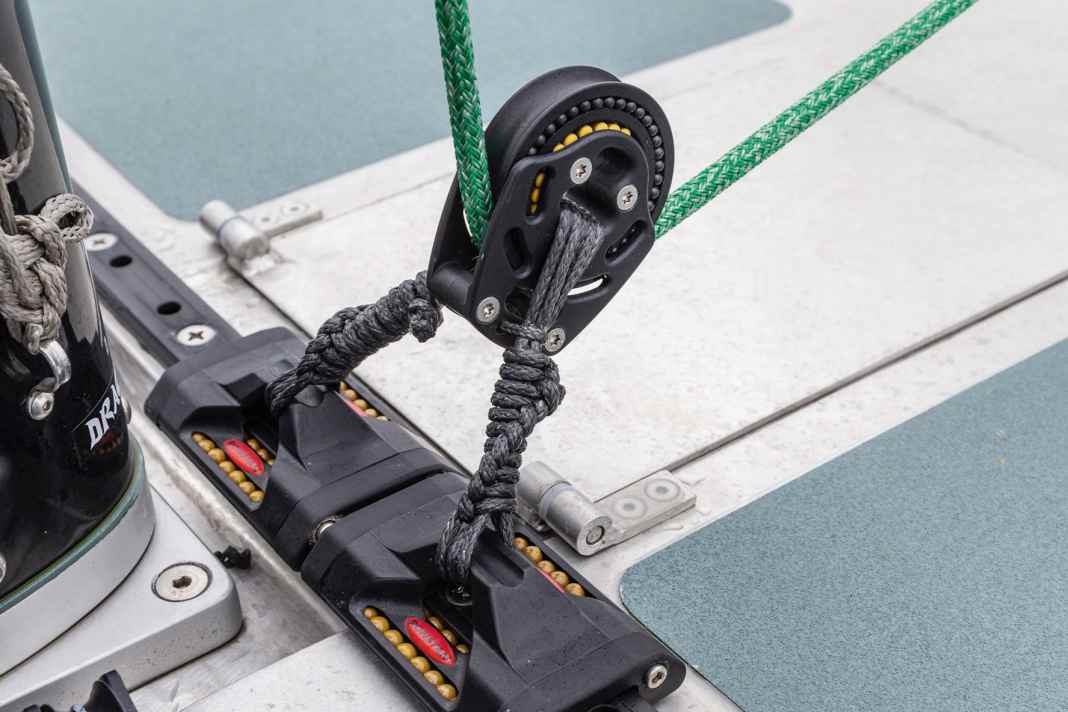



Smooth running with the highest loads
Roller, roller or needle roller bearings basically function like ball bearings, except that small cylindrical rollers are used instead of spherical bearing bodies. The rollers have a much larger contact surface than balls and can therefore withstand greater forces. Roller bearings do not run as smoothly as ball bearings under low loads, but offer the best compromise between load capacity and friction. Compared to plain bearing blocks, they exhibit less friction under both low and high loads. Above all, the breakaway torque typical of plain bearings is much lower with roller bearings, which means that heavily loaded timing devices can be adjusted more precisely.
However, these advantages come at the cost of a much more complex design. Even the rollers, which are usually made of Torlon, are more expensive than balls and, like plain bearings, they can only absorb radial forces. For this reason, the blocks usually have additional ball bearings on the sides of the pulleys. This is also reflected in the price of the blocks. With a similar working load, the Black Magic roller bearing block from Harken costs almost four times as much as a simple element plain bearing block. However, the Black Magic also has an internal cage that keeps the rollers at a distance and prevents them from rubbing against each other. Typical applications for roller bearing blocks are mainsheet systems on yachts over 35 feet. Especially systems where the sheet has to run through the blocks when trimming the traveller. Minimal friction under load is required here.
Valuation
- + Good for static load
- + Low friction
- - Elaborate design/very expensive
- - Must be rinsed
Thimbles: Slide bearing made of Dyneema
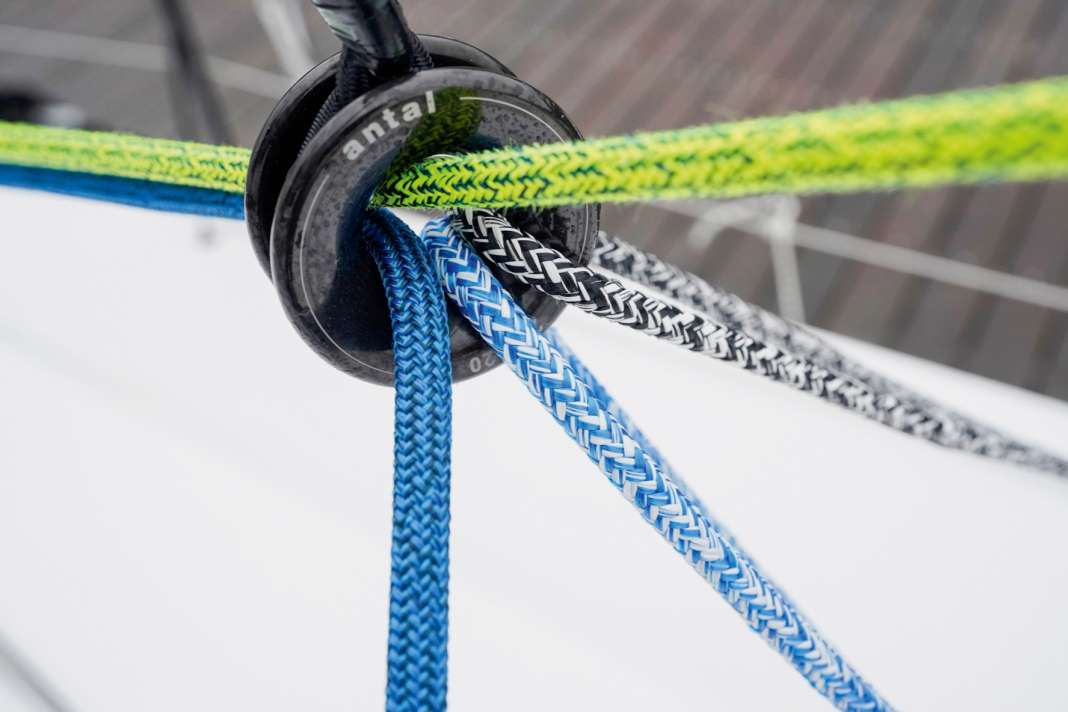



The smooth and soapy surface of the Dyneema fibre enables a new type of plain bearing block. Instead of rotating around a rigid metal axle, the disc rotates around a Dyneema braid. A simple aluminium thimble is used as the disc. It is hard to say who first came up with the idea for this unusual design. One of the first suppliers was the French company Ino-Rope. However, the principle was quickly adopted and is now also available from Antal as the Sector Ring or from Morfrac as the Morfblock, with the latter utilising an additional bearing shell.
What they all have in common is their extremely robust design and spectacular working load-to-weight ratios. Even the smallest Morfrac model has a working load of 225 kilograms at a weight of just six grams. Compared to a simple thimble, the blocks offer the advantage that sheathed ropes can also be deflected. In thimbles, the cover usually generates too much friction. The combination of a textile axle and metal thimble runs significantly heavier than a ball bearing block at low loads, but the efficiency improves with increasing tension. Morfrac advises dimensioning the blocks so that they are used at more than 25 per cent of the working load. The blocks are predestined for folding rotors.
Valuation
- + Extremely resilient
- + Maintenance-free
- + Simple construction
- - Moderate friction
What the bearings are made of
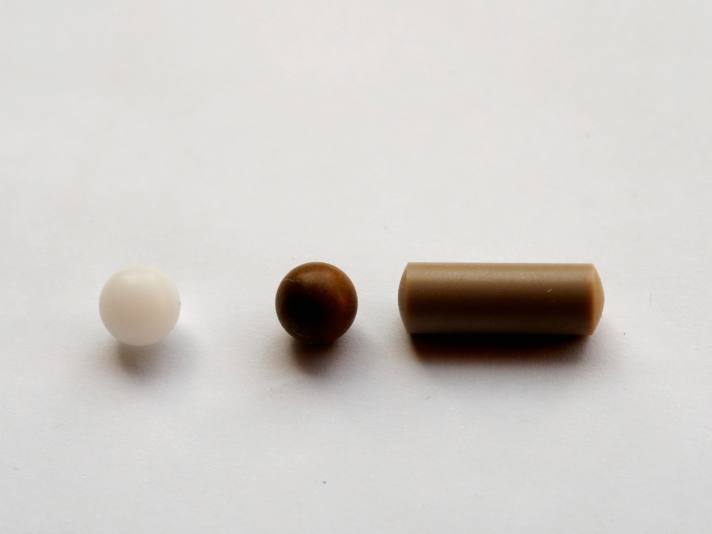
Delrin
The white plastic is also known as POM or acetal, has a low coefficient of friction and is relatively resistant to pressure and tension. It is used for discs and balls. However, the material is not suitable for high loads. To protect the balls from UV light, they are often coloured black or grey
Torlon
The brown high-performance polymer is more pressure-resistant than Delrin and is used in high-load blocks as a material for ball or roller bearings; it costs around five to ten times as much as Delrin
The influence of the deflection angle
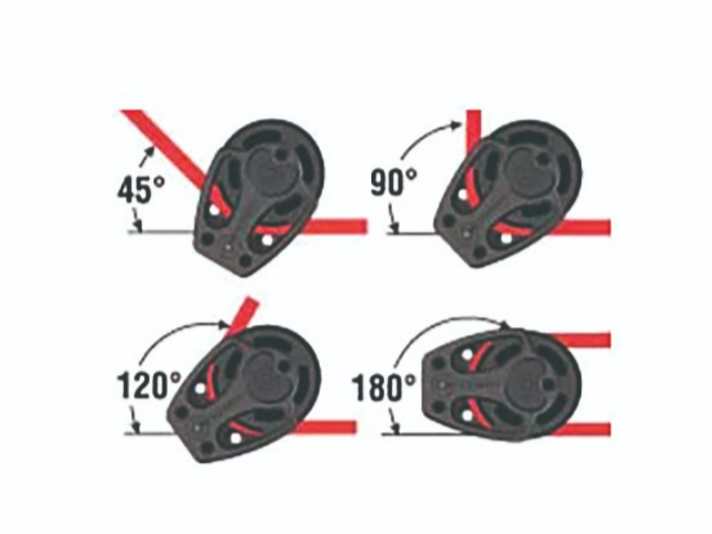
The forces acting on the discs depend on the load on the line and the deflection angle. If friction is neglected, the so-called load factor can be determined with a little trigonometry. The formula is: F = 2 x sine of half the deflection angle x pull on the line. Even at a moderate 30 degrees, the fitting has to cope with slightly more than half the pull. A change in direction of 90 degrees results in a factor of 1.41. 180 degrees means twice the load
How large the loads are
The forces that occur when sailing depend on the size and type of boat and the weather conditions. It is therefore almost impossible to make generalised statements. To estimate the sheet loads, the sail area is used as a guide. Corresponding formulae can be found in the support area of the Harken website, for example. There are also tables there for choosing the blocks
details
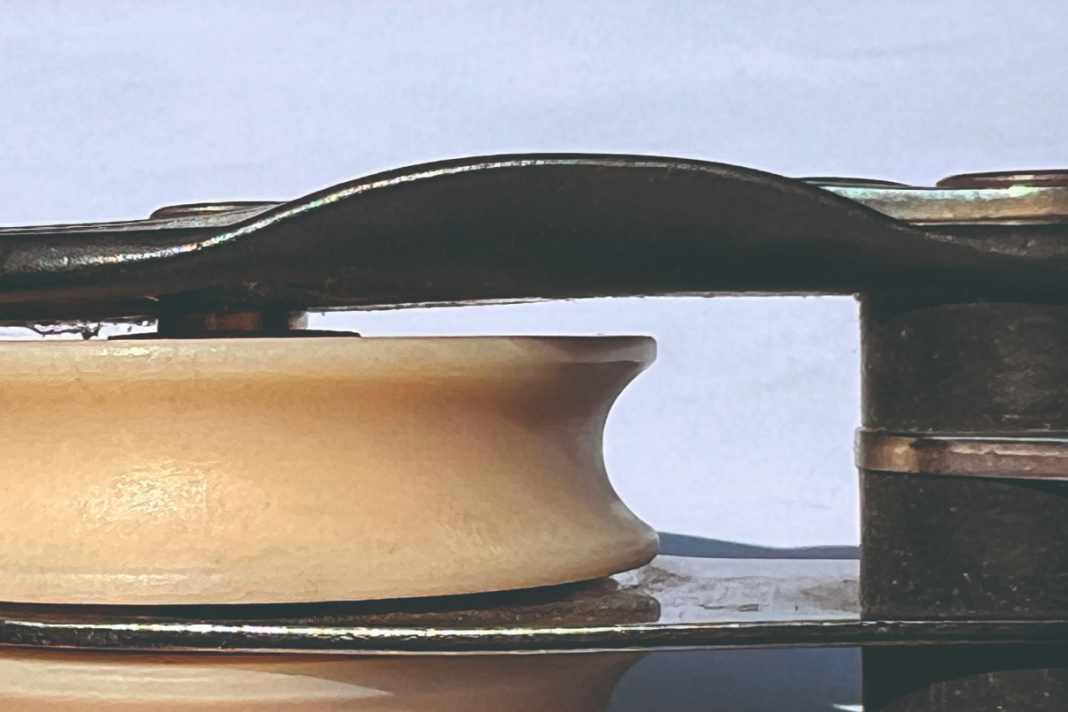


The subjective weak point of many blocks is their fastening. Bent bolts that can barely be turned out of the shackle are not uncommon. This is not necessarily a disadvantage, on the contrary. Manufacturers do not economise here, but sometimes use material thicknesses very cleverly. A good example of this are the Classic and Carbo blocks from Harken; in our test, they tore exactly at the specified breaking load. However, it is not the housing that flies to pieces, but the stainless steel shackle. Its change can be used as a load indicator. If something bends here, it is not the shackle that needs to be replaced, but the entire block - because it is undersized.
Double block or violin
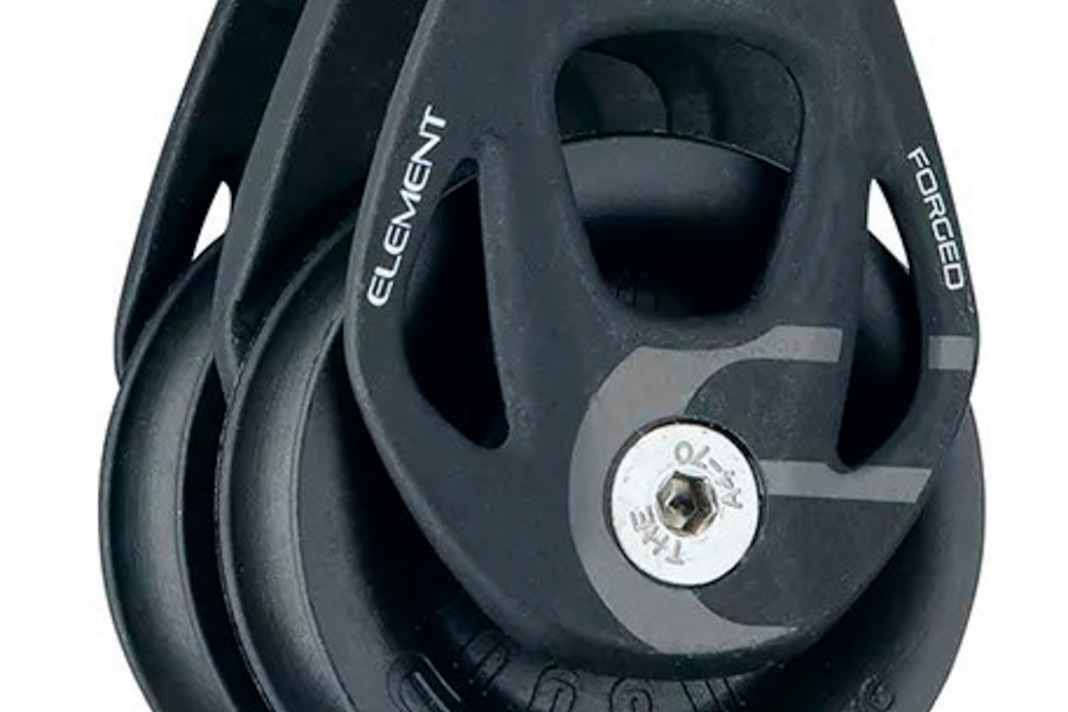


Multiple blocks are available with discs next to each other, or they are arranged one behind the other as with violin blocks. The great advantage of this design is that the discs with violins do not twist so easily. In addition, the discs do not tilt. This is unavoidable when the discs are grouped next to each other. The friction in the bearings distributes the load differently and causes the block to tilt. Slide bearing versions in particular have this problem. With violins, the rope has to run over a comparatively small disc, which results in slightly more friction. As the line runs more slowly there, the effect does not play a major role in practice.

